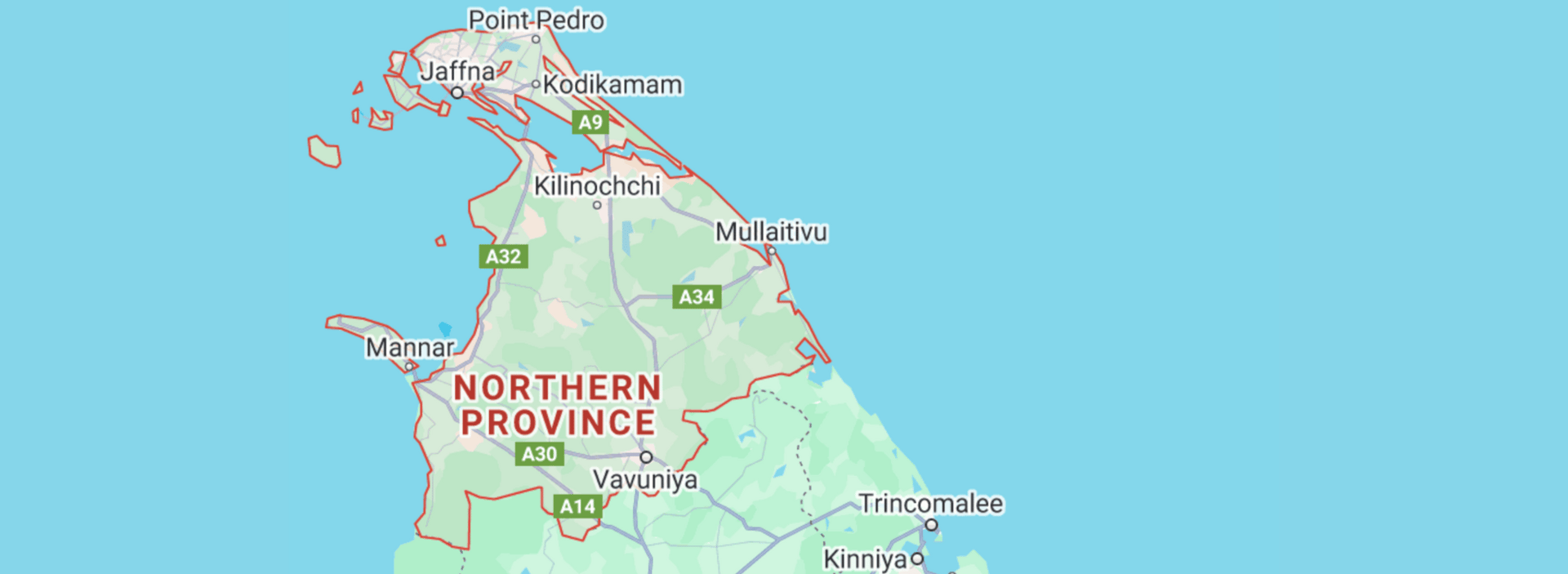
Northern Province
A Land of Resilience, Culture & Untamed Beauty
The Nestled at the northern tip of Sri Lanka, just 35 km from India, the Northern Province is a region steeped in Tamil heritage, colonial history, and post-war revival. Comprising the districts of Jaffna, Kilinochchi, Mullaitivu, Mannar, and Vavuniya, this province is where Sri Lanka’s Tamil-majority culture thrives, offering a unique blend of sacred temples, pristine beaches, and poignant war history.
Why Visit the Northern Province?
1. Jaffna: The Cultural Heart of Sri Lanka
The provincial capital, Jaffna, is a city of contrasts where Dutch forts stand beside vibrant Hindu kovils, and war scars fade amid bustling markets. Key attractions include:
Nallur Kandaswamy Kovil: A stunning Hindu temple hosting a 25-day festival in July/August, featuring fiery processions and devotees in trance
Jaffna Fort: A 17th-century Dutch stronghold with colonial-era buildings and ocean views
Jaffna Public Library: A symbol of Tamil resilience, rebuilt after being burned in 1981
Jaffna Cuisine: Must-try dishes like Jaffna crab curry, palmyrah toddy, and spicy mutton rolls
2. Untouched Beaches & Islands
The Jaffna Peninsula and nearby islands offer some of Sri Lanka’s most secluded shores:
Casuarina Beach: Powder-soft sands with shallow, turquoise waters—perfect for swimming
Delft Island (Neduntivu): Known for wild Portuguese-bred horses and limestone formations
Nagadeepa (Nainativu): A sacred island with the Nagadeepa Purana Raja Maha Viharaya (Buddhist) and Nagapooshani Amman Kovil (Hindu)
3. War History & Rebirth
Kilinochchi: Once the de facto capital of the LTTE, now a town rebuilding with museums and memorials
Mullaitivu: Site of the war’s final battle, now home to the Mullaitivu Peace Park
Vavuniya: A transit hub with the Vavuniya Museum, documenting the region’s wartime past
4. Sacred & Mystical Sites
Keerimalai Springs: Believed to heal skin ailments, with a temple built by a Pandyan princess
Kadurugoda Temple: Ancient Buddhist ruins with 60 miniature stupas, linked to a legend of poisoned monks
Madhu Church: A revered Catholic shrine in Mannar, drawing pilgrims since the 17th century
5. Wildlife & Nature
Mannar’s Birdlife: Flamingos, herons, and migratory birds in the Vankalai Sanctuary.
Adam’s Bridge (Rama’s Bridge): A chain of limestone shoals linking Sri Lanka to India, visible from Mannar.
Best Time to Visit
Dry Season (May–September): Ideal for beach visits and temple exploration
Festivals:
Nallur Festival (July/August): A vibrant Hindu celebration in Jaffna
Christmas in Madhu: A solemn yet festive pilgrimage
How to Get There?
By Train: The Yarl Devi Express from Colombo to Jaffna (8 hours) offers scenic views
By Air: Daily flights from Colombo to Jaffna International Airport (JAF)
By Road: A 6-hour drive from Colombo via the A9 highway
One of the most extraordinary geographic wonders in Sri Lanka can be experienced in Jaffna, where due to its northernmost location you can watch both the sunrise and sunset over the sea from the same spot!
Where Does This Happen?
At Sangiliyan Point (Sangili Thoppu), near Fort Jaffna, the Indian Ocean stretches to the east and west, allowing you to:
See the sunrise over the water in the morning (facing east).
Watch the sunset over the sea in the evening (facing west).
This rare phenomenon occurs because Jaffna sits on a narrow peninsula, with the ocean on both sides.
Best Time to Experience It
Sunrise: Around 5:45 AM - 6:15 AM (varies by season).
Sunset: Between 6:00 PM - 6:30 PM.
Ideal Season: April to September (clear skies, minimal monsoon interference).
Why Is This Special?
Most coastal cities face either east (sunrise) or west (sunset), but Jaffna’s unique geography allows both events to happen over water a rare treat for photographers and nature lovers who are eying for a rare post on Instagram or Tiktok!



